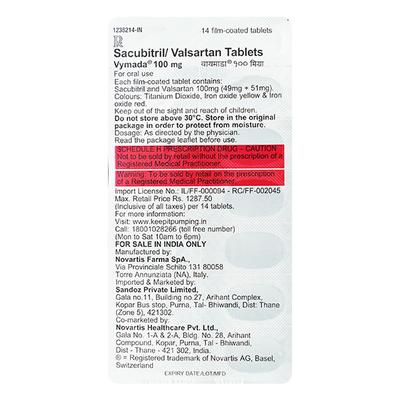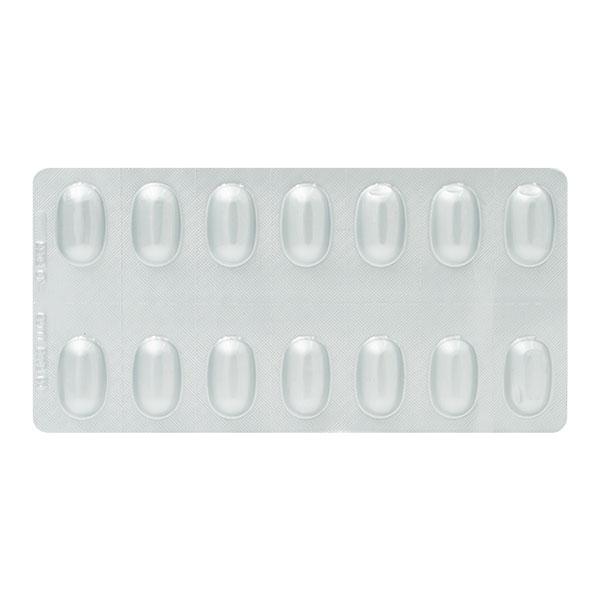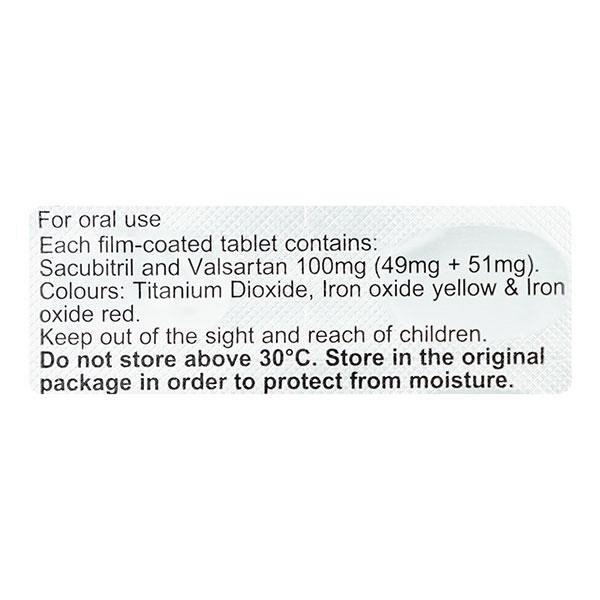

Netmeds First Membership
Quick Links
Introduction About VYMADA 100MG TABLET
Vymada Tablet is indicated to reduce the risk of cardiovascular death and hospitalization for heart failure in patients with chronic heart failure (New York Heart Association Class II-IV) and reduced ejection fraction. VYMADA 100MG TABLET contains a combination of sacubitril and valsartan, available as a film-coated tablet for oral use.
Before taking Vymada Tablet, inform your doctor if you have liver, kidney, or heart problems. It is not recommended for use in pregnant and breast-feeding women. This medicine is not suitable for use in children and adolescents under 18 years of age, and it should be used with caution in elderly patients (65 years of age and above).
Before taking Vymada Tablet, inform your doctor about previous allergies and medication history to manage any serious effects. Common side effects of taking this medicine are dizziness, cough, headache, tiredness, nausea, and weakness. Consult your doctor if any of the side effects worsen.
Key Composition
- Sacubitril
- Valsartan
Uses Of VYMADA 100MG TABLET
Benefits of VYMADA 100MG TABLET
- Improved heart function by reducing strain on the heart
- Helps manage symptoms such as breathlessness, fatigue, and swelling
- Lowers the risk of hospitalization due to heart failure complications
- Enhances overall quality of life for patients with heart failure
- Supports better cardiac efficiency through dual-action mechanism
- May extend lifespan by reducing cardiovascular-related risks
- Helps maintain optimal blood pressure via vessel relaxation and reduced resistance
- Aids in fluid balance regulation through increased sodium excretion and vasodilation
How VYMADA 100MG TABLET Works
The mechanism of action of VYMADA 100MG TABLET involves a dual-action pharmacological effect from its two components, sacubitril and valsartan, classified as an angiotensin receptor neprilysin inhibitor (ARNI).
- Sacubitril is a prodrug metabolized to LBQ657, which inhibits neprilysin, an enzyme that degrades beneficial vasoactive peptides like natriuretic peptides, bradykinin, and adrenomedullin. By inhibiting neprilysin, sacubitril increases these peptides' levels, promoting vasodilation (relaxation of blood vessels), enhanced sodium excretion through urine, and increased urination. These actions help reduce blood pressure and alleviate cardiac workload.
- Valsartan blocks the angiotensin II type 1 (AT1) receptor, preventing angiotensin II from causing vasoconstriction and aldosterone secretion. This blockade leads to blood vessel relaxation, reduced extracellular fluid volume, and lower blood pressure, making it easier for the heart to pump blood effectively.
Together, sacubitril and valsartan complement each other by enhancing natriuretic peptide effects while inhibiting the harmful effects of angiotensin II, promoting improved cardiac efficiency and reduced cardiovascular strain.
How to use VYMADA 100MG TABLET
- Swallow the tablet whole with water.
- Can be taken with or without food.
- Take at the same time each day to maintain consistent blood levels.
- Do not crush, chew, or break the tablet.
- Follow the exact dose and schedule prescribed by your doctor.
VYMADA 100MG Dosage Guidelines
- Typical starting dose: 100 mg twice daily.
- Dose adjustments may be made based on patient response and tolerability.
- Dose can be doubled after 2-4 weeks if needed, as per doctor’s advice.
- Do not exceed the prescribed dose.
- Regular monitoring of blood pressure and kidney function is recommended.
Step-by-Step Administration Advice
- Take tablet by mouth with a full glass of water.
- Maintain a consistent dosing schedule daily.
- Avoid stopping the medication abruptly without consulting your doctor.
Dosage Titration and Monitoring
- Dose may be gradually increased to target dose based on clinical evaluation.
- Blood pressure, kidney function, and potassium levels should be monitored regularly.
- Adjustments in dose are individualized to minimize side effects and maximize benefits.
Oral Tablet Intake Methods
- Take tablets with water to ensure proper swallowing.
- Tablets should not be crushed, chewed, or split.
- Can be taken irrespective of meals, but consistency is key.
Safe Dosage Adjustments for Special Populations
- Patients with kidney or liver impairment may require dose adjustments; consult a doctor.
- Not recommended during pregnancy and breastfeeding.
- Caution in elderly patients; start at lower dose and monitor closely.
- Avoid concurrent use with ACE inhibitors; maintain a gap of at least 36 hours between drugs
What if I forgot to take VYMADA 100MG TABLET
- If a dose is missed, take it as soon as you remember.
- Skip the missed dose if it is almost time for the next dose.
- Do not double the dose to make up for a missed one.
Overdose
- If you or anyone else accidentally takes too much of Vymada 100 Tablet, contact your doctor immediately or go to the nearest hospital straight away. Symptoms include severe dizziness and fainting.
Side Effects Of VYMADA 100MG TABLET
- Dizziness, lightheadedness (low blood pressure)
- Signs of high levels of potassium in the blood (irregular heartbeat, muscle weakness)
- Decrease in renal function
- Cough
- Diarrhoea
- Signs of low red blood cells (anemia)
- Tiredness, weakness
- Headache
- Fainting or spinning sensation
- Nausea
- Inflammation of the lining of the stomach (stomach pain, nausea)
- Signs of low sugar levels in the blood (fast heartbeat, sweating, nervousness, or anxiety)
When to consult your doctor
- Severe allergic reactions (swelling of the face, lips, tongue, or throat, which may cause difficulties in breathing or swallowing (angioedema))
Warning & Precautions
Pregnancy
ContraindicatedVymada Tablet is not recommended for use in early pregnancy and must not be used in pregnant women when more than 3 months pregnant, as it may cause serious harm to the baby.
Breastfeeding
ContraindicatedVymada Tablet is not recommended for use in breastfeeding women.
Driving and Using Machines
Use with CautionAvoid driving or handling any machines while taking the Vymada Tablet because it may cause dizziness or tiredness.
Kidney
Use with CautionVymada Tablet should be used with caution in patients with severe kidney disease and with narrowed kidney arteries.
Liver
Consult your doctorVymada Tablet is not recommended for use in patients with severe liver disease, and it should be used with caution in patients with liver disease.
Allergy
ContraindicatedDo not take Vymada Tablet if you are allergic (hypersensitive) to Sacubitril and Valsartan.
Use In Pediatrics
ContraindicatedVymada Tablet is generally not recommended for use in children and adolescents (under 18 years of age).
Use In Geriatrics
Use with CautionVymada Tablet should be used with caution in elderly patients (above 65 years of age).
Other Warnings for VYMADA 100MG TABLET
Before taking Vymada 100 Tablet, inform your doctor if you have:
- History of angioedema
- Low blood pressure
- Vomiting or diarrhea
- Dehydration
- Hallucinations, paranoia, or changes in sleeping pattern
Who should not take [GBNKEYWORD
Vymada Tablet is not recommended for use if you have:
- Diabetes or impaired kidney function (and being managed with aliskiren (blood pressure lowering medicine))
- Personal or family history of angioedema (when taking angiotensin receptor blockers (ARB) such as valsartan, telmisartan)
Diet and Lifestyle Advice
Diet Recommendations
- Limit Salt (Sodium) Intake: Excess salt can raise blood pressure and cause fluid retention, which can worsen heart failure symptoms. Aim for a low-sodium diet.
- Control Potassium Intake: Depending on the patient's potassium levels and doctor’s advice, avoid excessive potassium-rich foods or potassium supplements to prevent hyperkalemia.
- Balanced Heart-Healthy Diet: Focus on fruits, vegetables, whole grains, lean proteins (such as fish, poultry), and healthy fats (like those from nuts and olive oil).
- Avoid Excessive Alcohol: Alcohol can affect blood pressure and interact with medication; limit consumption as per healthcare provider guidance.
- Stay Hydrated: Drink adequate water unless restricted by a healthcare provider.
Lifestyle Recommendations
- Regular Exercise: Engage in moderate physical activity as advised by a doctor, such as walking, swimming, or light aerobic exercises to improve cardiovascular fitness.
- Weight Management: Maintain a healthy weight to reduce cardiac strain.
- Monitor Symptoms: Keep track of swelling, breathlessness, or weight changes and report to healthcare providers.
- Avoid Smoking: Smoking damages blood vessels and worsens heart conditions.
- Manage Stress: Practice relaxation techniques like meditation or yoga to help control blood pressure and improve overall wellbeing.
- Regular Medical Check-ups: Follow-up visits and lab tests for kidney function, electrolytes, and blood pressure monitoring.
Interactions
- ACE inhibitors (e.g., enalapril, lisinopril, ramipril): Concurrent use is contraindicated due to increased risk of angioedema. A 36-hour washout period is required when switching between these drugs and VYMADA.
- Aliskiren: Not recommended for use with VYMADA in diabetic or renal-impaired patients due to increased risk of adverse effects like hypotension and hyperkalemia.
- Angiotensin receptor blockers (other ARBs like telmisartan, losartan): Avoid using alongside VYMADA because valsartan is already present in it.
- Potassium-sparing diuretics, potassium supplements, or salt substitutes containing potassium: Can increase risk of hyperkalemia; monitor potassium levels closely.
- NSAIDs (e.g., ibuprofen, indomethacin, celecoxib): May reduce renal function and blunt antihypertensive effects.
- Lithium: Potential for increased lithium toxicity.
- Warfarin and heparin: May have interaction concerns; inform your doctor.
- Sildenafil: Caution advised due to additive blood pressure-lowering effects.
- Furosemide: Careful monitoring is required when combined.
- Nitroglycerine: Combined use may increase blood pressure-lowering effects.
- Rifamycin and Ciclosporin: Potential interactions; caution and monitoring needed.
- Ritonavir: May cause drug interaction; consult healthcare provider.
- Metformin: Monitor blood glucose and kidney function carefully.
Synopsis
| Drug | : | Sacubitril and Valsartan |
| Pharmacological Category | : | Neprilysin Inhibitor, Angiotensin II Receptor Blocker |
| Therapeutic Indication | : | Heart failure |
| Dosage Forms | : | Tablet |
More Information
Did you know
- Did you know that consistent use of VYMADA, as prescribed, may reduce the risk of hospitalizations related to heart failure symptoms?
- Did you know that VYMADA may require periodic blood tests to monitor kidney function and potassium levels for safe and optimal use?
- Did you know that this medication should not be combined with ACE inhibitors without a recommended 36-hour gap to avoid serious side effects like angioedema?
- Did you know that VYMADA is typically taken twice daily, but adherence to timing and dosage instructions is essential for the best outcome?
- Did you know that lifestyle factors such as limiting salt intake, regular exercise, and avoiding smoking can greatly enhance the benefits of VYMADA?
Comparison table
|
Feature |
VYMADA 100MG TABLET |
Enalapril Tablet |
|
Active Ingredients |
Sacubitril + Valsartan |
Enalapril Maleate |
|
Drug Class |
Angiotensin Receptor Neprilysin Inhibitor (ARNI) |
Angiotensin-Converting Enzyme Inhibitor (ACE inhibitor) |
|
Typical Dosage |
100 mg twice daily (may be adjusted) |
5-20 mg daily (dose adjusted by doctor) |
|
Mechanism of Action |
Dual action: Neprilysin inhibition + AT1 receptor blockade for vasodilation and natriuresis |
Blocks conversion of angiotensin I to II, reducing vasoconstriction |
|
Common Uses |
Support in heart failure, reduces hospitalization risk |
Used in hypertension, heart failure, kidney protection |
|
Side Effects |
Dizziness, hyperkalemia, hypotension, cough (less common than ACE inhibitors) |
Cough (common), dizziness, kidney function changes |
|
Warnings & Precautions |
Avoid with ACE inhibitors; monitor potassium and kidney function |
Avoid during pregnancy; monitor kidney function and potassium levels |
|
Administration |
Oral, can be taken with or without food |
Oral, usually taken without food |
|
Special Population Use |
Dose adjustments for renal/liver impairment; caution in elderly |
Similar dose adjustments; contraindicated in pregnancy |
|
Storage |
Store below 30°C, protect from moisture and sunlight |
Store in a cool, dry place |
FAQs About VYMADA 100MG TABLET
Q: What is Vymada 100 used for?
A: Vymada 100 is used to manage chronic heart failure in patients with a reduced ejection fraction (HFrEF), specifically New York Heart Association (NYHA) Class II-IV. It helps reduce the risk of cardiovascular death and hospitalization caused by heart failure. Vymada works by improving the heart's efficiency and reducing the strain on the heart, helping to manage symptoms such as fatigue, breathlessness, and fluid retention.
Q: What is the function of Vymada?
A: Vymada combines two medications, Sacubitril and Valsartan, which work together to relax blood vessels by reducing resistance and allows blood to flow more easily, lowering blood pressure which helps in the management of hypertension and reducing the strain on the heart. It also improves heart function where sacubitril helps in removal of excess sodium and water, while Valsartan blocks angiotensin II, reducing vasoconstriction and preventing heart strain. Together, they enhance heart efficiency and improve quality of life in heart failure patients.
Q: What are the side effects of Vymada for kidneys?
A: Vymada may cause reduced kidney function in some patients. Potential side effects includes increased creatinine levels, electrolyte imbalances like high potassium levels (hyperkalemia), Dizziness, fatigue, swelling, or reduced urine output.
Q: What happens when you stop taking Vymada?
A: Stopping Vymada abruptly can worsen heart failure symptoms, such as breathlessness, fluid retention, and fatigue. The heart may work less efficiently, increasing the risk of complications. Always consult your doctor before stopping or adjusting the dosage of Vymada, as a gradual change might be necessary to avoid complications.
Q: How effective is Vymada?
A: Vymada is highly effective in managing chronic heart failure. Clinical trials, such as the PARADIGM-HF study, have shown that Vymada significantly reduces cardiovascular death risk, hospitalization rates for heart failure and symptoms of heart failure, such as fatigue and shortness of breath. It improves overall quality of life by enhancing heart function and managing fluid retention.
Q: Can valsartan damage kidneys?
A: Valsartan, a component of Vymada, may potentially affect kidney function, particularly in patients with pre-existing kidney disease or dehydration. Therefore, patients with pre-existing kidney condition must be closely monitored.
Q: What are the indications for Vymada?
A: Vymada is indicated for heart failure with reduced ejection fraction especially in patients requiring better management than conventional therapies. It is specifically designed for patients who need comprehensive management of heart function and fluid balance.
Q: When is the best time to take sacubitril valsartan?
A: Sacubitril-Valsartan (Vymada) can be taken once or twice daily as prescribed by your doctor. While it can be taken with or without food, consistent timing helps maintain stable drug levels in your body. Consult your doctor about the optimal schedule based on your condition.
Q: Should I drink a lot of water with valsartan?
A: It’s important to maintain adequate hydration, but excessive water intake should be avoided, especially if your doctor has recommended fluid restrictions due to heart failure or kidney issues. Follow your doctor’s advice regarding water consumption to avoid exacerbating fluid retention or electrolyte imbalances.
Q: Does Vymada increase blood sugar?
A: Vymada is generally not associated with significant increases in blood sugar levels. However, in some patients, particularly those with diabetes, blood sugar levels may fluctuate. Regular monitoring of blood glucose is advised for diabetic patients while on Vymada.
Q: When is the best time of day to take valsartan?
A: Valsartan, a component of Vymada, can be taken at any time of day, but it is most effective when taken at the same time daily. Your doctor may recommend a specific time based on your routine, but consistency is key for optimal blood pressure and heart failure management.
Q: What is the benefit of Vymada 100mg?
A: Vymada 100mg helps manage chronic heart failure by improving heart efficiency, reducing symptoms like breathlessness and fatigue and lowering the risk of hospitalization and cardiovascular-related death. Its dual action on blood pressure and heart failure symptoms makes it an effective and comprehensive therapy.
Q: Does Vymada lower blood pressure?
A: Yes, Vymada lowers blood pressure by relaxing and dilating blood vessels, which decreases the workload on the heart. This helps reduce symptoms and prevents complications in heart failure patients.
Q: What is another name for Vymada?
A: Vymada is the brand name for the combination drug Sacubitril and Valsartan. In other regions, it may also be sold under the brand name Entresto.
Q: What is the most common adverse effect of Sacubitril valsartan?
A: The most common side effects include dizziness and lightheadedness due to lowered blood pressure, hypotension (low blood pressure), hyperkalemia (high potassium levels), which can cause fatigue and irregular heartbeat. Consult your doctor if you experience any of these symptoms for proper management.Bottom of Form
Q: Is valsartan good for your heart?
A: Yes, Valsartan is highly beneficial for the heart. It blocks the action of angiotensin II, a hormone that narrows blood vessels, leading to reduced blood pressure, decreased heart strain and improved outcomes in patients with heart failure and hypertension.
References
1. KD Tripathi. Cardiovascular drugs. Essentials of Medical Pharmacology. Seventh Edition. New Delhi, May 2013. Page-508.
2. Loretta Fala. Entresto (Sacubitril/Valsartan): First-in-Class Angiotensin Receptor Neprilysin Inhibitor FDA Approved for Patients with Heart Failure. NCBI; PMC. Pubmed Central. National Library of Medicine, National Institute of Health. September 2018. [Accessed on 29th September 2025] ![]()
3. Peter Khalil, Ghazal Kabbach, Sarmad Said, and Debabrata Mukherje. Entresto, a New Panacea for Heart Failure. NIH National Library of Medicine, National Center for Biotechnology Information. Pubmed.gov. 2018. [Accessed on 29th September 2025] 
4. Novartis Pharmaceuticals UK Ltd. Electronic Medicines Compendium (EMC) [Revised in May 2021] [Accessed on 29th September 2025] 
5. Cipla Ltd. Arnicor Tablets (Sacubitril/Valsartan). Ciplamed. [Revised in July 2024] [Accessed on 29th September 2025] 










